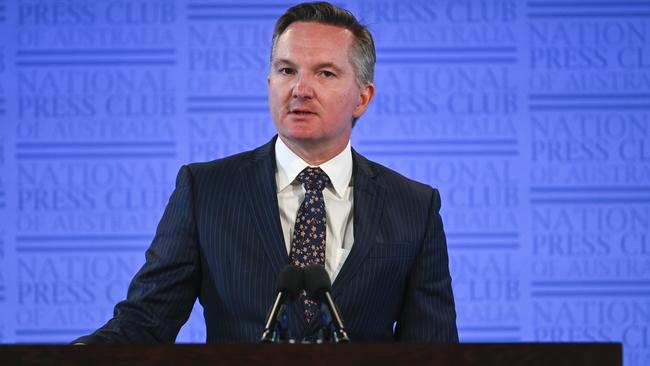Chris Bowen admits to negative gearing blowout
Chris Bowen has abandoned his previous claim only 7 per cent of investors buy new dwellings, and produced new figures.

Chris Bowen, who could soon be managing the country’s finances as Labor’s treasurer, has been forced to unveil a blowout in the number of investors who are likely to claim tax concessions under his signature negative gearing policy.
Mr Bowen, who was caught out using incorrect numbers to promote his plan, revealed under questioning at the National Press Club yesterday that many more investors are now forecast to be eligible to negatively gear their new properties under Labor’s policy.
The revised figures prompted calls for him to release the entire costing of the policy.
The opposition Treasury spokesman admitted the Parliamentary Budget Office rewrote its forecasts in the past year on the number of investors who would buy new property and receive the tax break, but denied Josh Frydenberg’s claim there was a “black hole” in Labor’s costings.
It was another misstep for the would-be treasurer, who last year was forced to amend the party’s contentious franking credits policy to exempt pensioners.
Mr Bowen said the latest PBO costing from March assumed that 22 per cent of new property investors would buy newly built homes and negatively gear them under the first year of the policy — a marked increase on the 12 per cent figure that underpinned the 2016 costing when Labor first unveiled its proposal.
“When they first modelled our policy, they assumed 12 per cent new dwelling (investment),” Mr Bowen said in an address to the National Press Club in Canberra.
“We asked them to update our costings after every budget and MYEFO (mid-year economic and fiscal outlook), a standard procedure. They lifted that to 22 per cent.”
Under Labor’s policy, negative gearing would be restricted to new dwellings and grandfathered for people using the tax break on existing homes.
Mr Bowen was forced to release the updated data after being caught out using incorrect information to promote his negative gearing policy.
For the past three years, Mr Bowen has said that just 7 per cent of property investors bought new dwellings under the existing rules — a claim that he repeated as recently as January.
He wrongly attributed this data to the Australian Bureau of Statistics.
The PBO’s 2016 costings forecast that the negative gearing and capital gains crackdowns combined would raise $1.9 billion over the forward estimates and $37.3bn over a decade.
Last month, the PBO said they would raise $2.9bn over the next four years and $35.1bn over the decade — despite the increase in the number of investors who would receive the tax break.
The Treasurer yesterday launched an attack over Labor’s use of the inaccurate 7 per cent figure prior to Mr Bowen’s Press Club speech, after the ABS declared it did not collect that kind of data and was not the source of the 7 per cent figure.
“There’s a black hole in their costings,” Mr Frydenberg told 2GB radio. “Because, if the number of negative gearers who buy new homes is higher than the number that the Labor Party has been saying, which is what … the Housing Industry Association and the ABS and the Grattan Institute are saying to us, then they have overstated the amount of savings that they will get from this policy.
“Clearly they are (lying) and clearly there is a black hole in their costings … they have overstated the amount of savings they will get from this policy, and this is a $35bn slug on the taxpayer.”
Mr Bowen yesterday crab-walked away from the 7 per cent figure but refused to say how he came up with it.
He denied the figure was used by the PBO to come up with Labor’s costing but said it was used to showcase the “failure” of the current policy to encourage construction.
“They (the PBO) make all sorts of assumptions based on the best evidence available to them — not just ABS figures,” Mr Bowen said.
“They have access to unpublished data by the Reserve Bank. They talk to the big four banks. They collect their data from a whole range of circumstances and they reach a prudent assumption. A considered assumption which they say is then their best estimate.
“On a prudent basis, some could argue they take a small-c conservative approach to make sure their costing is right.”
Housing Industry Association principal economist Tim Reardon yesterday demanded Labor admit where it sourced its now abandoned 7 per cent figure. “The ABS don’t know the answer to the question ‘what is the value of investment going into new housing stock?’” Mr Reardon said.
“We the industry don’t know the answer. But we suspect it’s north of 30 per cent. In the absence of an answer to that question, the question to the ALP is: do they still believe it will increase the supply of new housing? All evidence is to the contrary from our perspective.”
Speaking in January, Mr Bowen said: “The most recent Australian Bureau of Statistics data shows that 93 per cent of new investment loans go to people purchasing existing housing stock.”



To join the conversation, please log in. Don't have an account? Register
Join the conversation, you are commenting as Logout